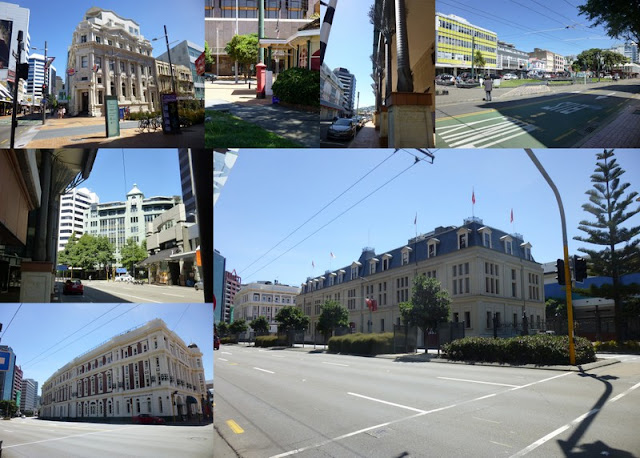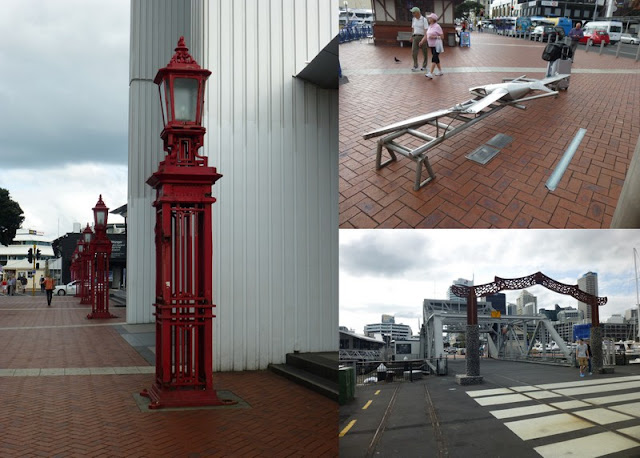January 28, 2013 at anchor Akaroa, New Zealand – Where the Passengers Outnumber the Locals
J had just started his morning walk when the Silver Whisper
passed the heads of Akaroa harbor; then we began a one-hour transit up the “Long
Harbor,” as it was called by the Maoris.
The ship anchored off the village of Akaroa at 8:00am, joining two other
cruise ships in the harbor. Akaroa is a
village of about 500 full-time residents and normally, another 500 tourists in
the summer season. It was about to be
invaded by approximately 3,000 cruise-ship passengers, mostly from a 2,000 plus
Princess cruise ship. Disaster in the
making!
Sunrise over the
Heads, Akaroa Harbor
The Banks Peninsula forms the left head.
Hail, Hail, the Gang’s
All Here
Just what you always wanted to attend -- a cruise ship
convention.
Use of Akaroa as a cruise-ship port was caused by the
Christchurch earthquakes, which have made Christchurch’s port, Littleton,
unusable. The story that we were told: the seafloor on the north side of the Banks
peninsula rose during the earthquake, making the port too shallow for large-draft
vessels. Also, Christchurch is
reportedly not “ready” to accept tourists.
Consequently, Akaroa is the only substitute port for cruise ships on the
South Island’s east coast, north of Port Chalmers (Dunedin).
The village of Akaroa has an interesting history. It was originally settled by French colonists
in 1840. The French wanted to establish
a presence in New Zealand to balance the growing British influence in the
southwest Pacific. However, belatedly, they
landed colonists at Akaroa just after the British had claimed sovereignty of all
New Zealand and signed the Treaty of Waitangi with the Maori. Those French colonists remained and were
gradually assimilated with British settlers.
Today, most of the “Frenchness” of Akaroa is nothing more than a tourist
hook.
Finishing breakfast, we prepared ourselves for the tender
ride into the Akaroa pier. We had been
warned by Fernando, the cruise director, that there might be some “congestion” at
the pier. Theoretically, the long tender
run into the pier takes about 30 minutes. With congestion, it was about 45 minutes
before we were “feet dry” on the pier.
There were tourists everywhere. It
was like a plague of locusts!
Relocated Akaroa
Lighthouse from 1879
This peaceful scene will shortly turn to passenger chaos!
Slogging our way through the mass of passengers on the pier,
we finally made Akaroa’s main street, Beach Road, and began our walk. It was like facing the sidewalks of mid-town Manhattan,
so we took the first side street and found that Akaroa without cruise-ship
passengers was a quaint village with a number of interesting public buildings
and private homes. Many houses were
B&B’s, home stays, or specialty shops.
Houses
Quaint houses, now home stays, B&Bs, or specialty shops.
Civic and Commercial
Buildings
Dating back to the 19th Century, many are still
in use.
Sometimes,
walking gives you access to little tableaus that are worth reporting:
The
following sign was seen at a local al fresco restaurant:
OK, As Long As It Is
ONLY Food
Question: Is
admitting the possibility of food theft a good marketing strategy?
Just across
the street on the beach was this hungry-looking flock.
Call the Cops! We have found the food thieves.
Question: Does your
lunch take precedent over survival of the species?
By 1:00pm,
most of the cruise-ship passengers had disappeared, either into the local food
factories or back to their ships – floating food factories. Meandering at a leisurely pace along the
beach front was a relaxing change. Not
once were we subjected to shoving by an overweight American woman, who just had
to have that refrigerator magnet.
Where Have All the
Passengers Gone?
To find the passengers, follow the trail of food particles,
if you can get to them before the birds.
After
watching another game of tender congestion at the pier, we boarded the Silver Whisper’s
tender for the 30-minute run back to the ship.
On board, it was lunch on the pool deck, reading, cards, and afternoon
nap before trivia. Note: no birds joined us for lunch. We guess that they don’t like “seafood.” At 6:00pm, the ship upped anchor and set
course for Port Chalmers. We all gave a
sigh of relief as the other two cruise ships set course in the opposite
direction toward the North Island. Are
there more refrigerator magnets in that direction?
























.JPG)




















